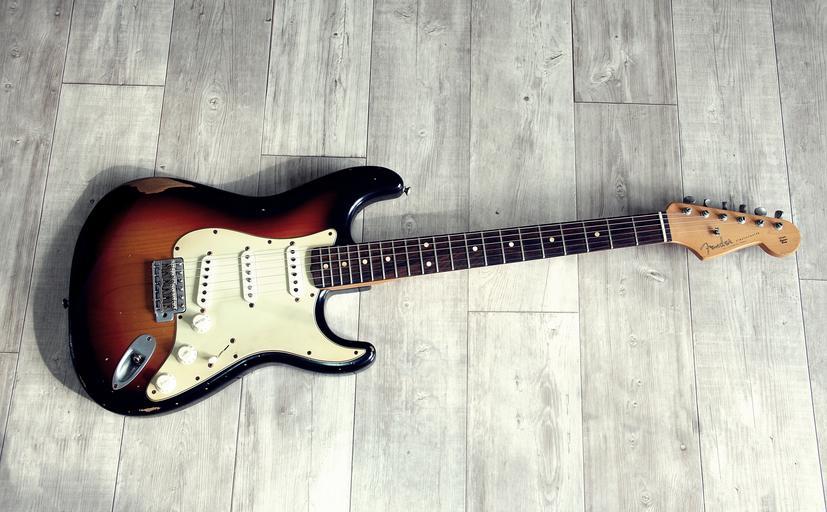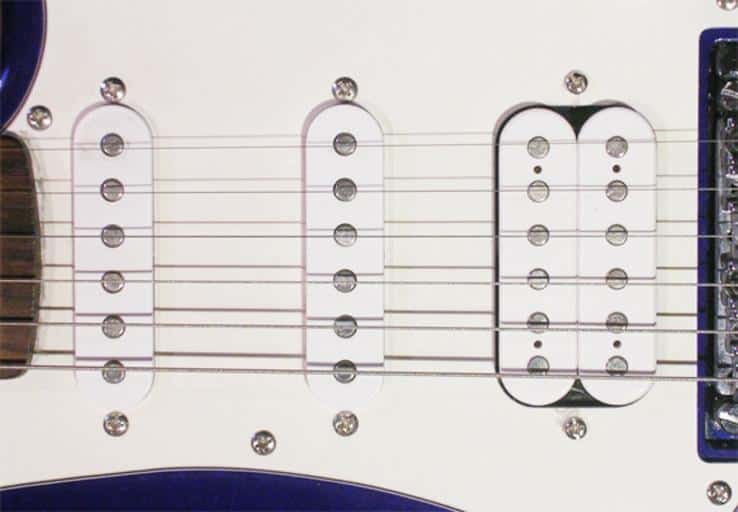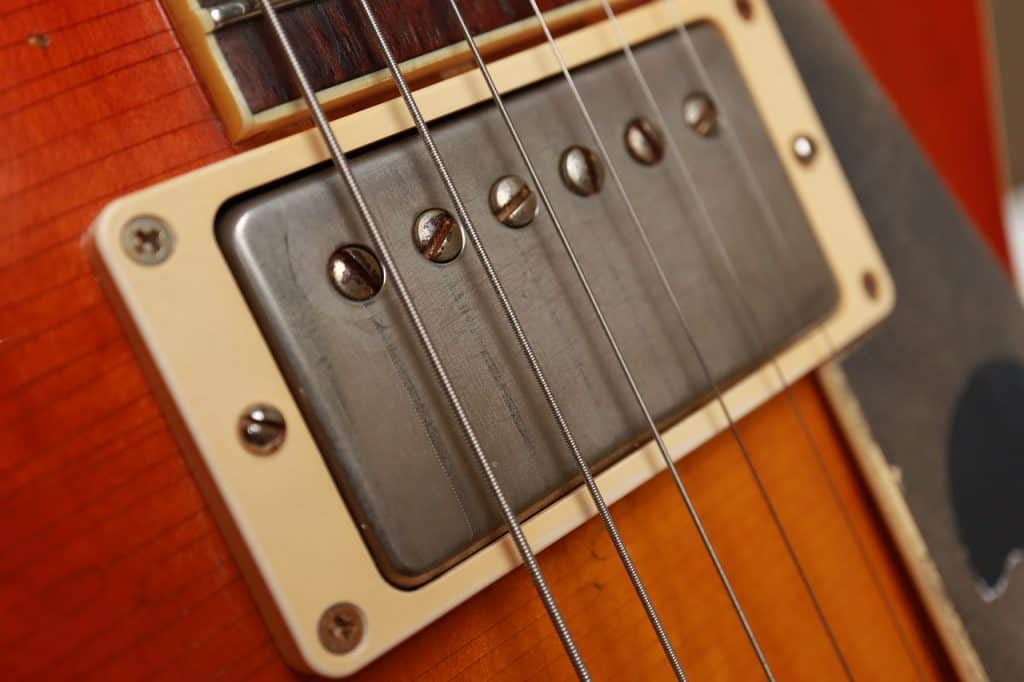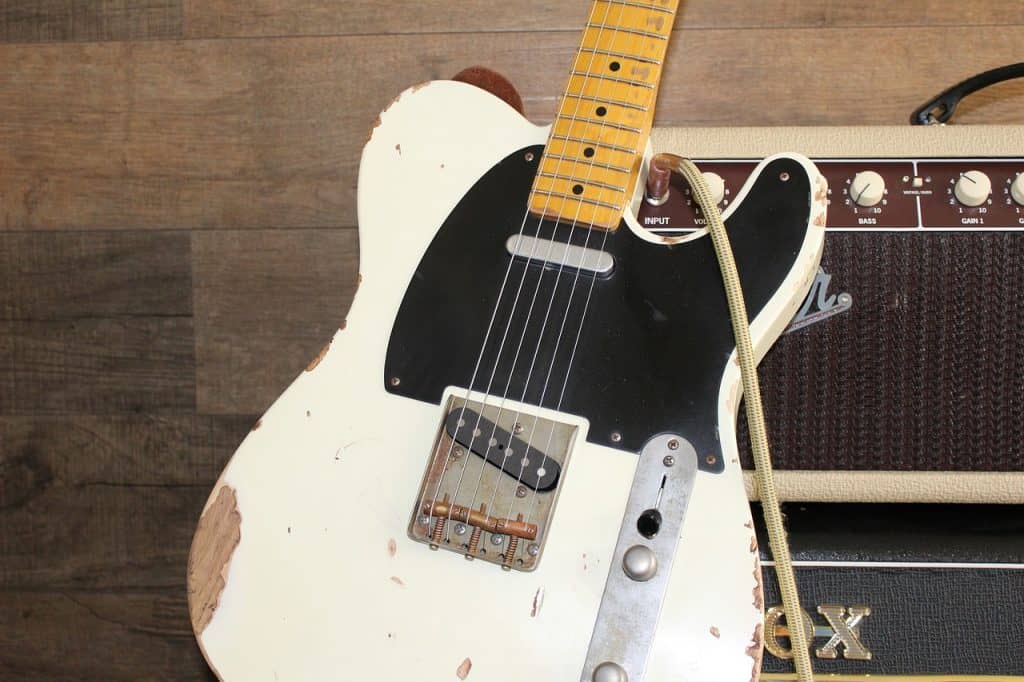Pickups can radically change and expand the tone of your guitar. Often, the best option to improve your sound is changing the pickups rather than buying a whole new guitar.
Why? Not only because it’s cheaper, but also because the unique customization you achieve adding pickups to a guitar gives you a sound hard to achieve by buying a new guitar.
This is a guide about DiMarzio pickups as I personally believe these are the best ones. More so, DiMarzio makes it very easy for you to choose the exact pickup you need.
This also a guide about how to change your guitar’s pickups and why and when you should do it. Needless to say, you will learn everything about guitar pickups along the way. If you’re new to guitar parts, you can start by reading this guide.
Think of it this way: while your guitar and your amp are the two most important factors on your guitar gig, the guitar’s pickup is the third one.
And by the end of the article, I’ll share some of the best pickups you can buy right now to take your guitar’s sound from zero to hero. Most are either DiMarzio or Seymour Duncan.
Contents
Following this guide, you will learn:
- Why DiMarzio pickups?
- Why you should improve your guitar with a pickup?;
- When to improve your guitar with a new pickup;
- What will changing the guitar’s pickup achieve?;
- Understanding guitar pickups
- Choosing the right pickup for you;
- Pickups I recommend and the best DiMarzio alternative’s
- How does a guitar pedal work?;
- Changing the guitar’s pickup.
In the meantime, here’s a video tutorial showing how pickups generally work. It’ll set you on the right path to understanding this critical part of electric guitars.
Why DiMarzo pickups?
DiMarzio is one of the top pickup builder brands. Aside from that, they have several advantages that will be great for you:
- For heavy metal and hard rock genres, DiMarzio and Seymour Duncan are at the top of the industry.
- DiMarzio’s webpage has a “Pickup Picker” that makes it easier for you to choose the exact device you want. It’s a good choice for both beginner and professional guitar players as most pickups come with an original name that says nothing about its features and characteristics.
- DiMarzio pickups are budget and top-quality.
- All DiMarzio pickups can combine with themselves.
By the end of the guide, choosing your next pickup will be very easy.
Why you should improve your guitar’s pickup?
In essence, the pickup is the link between your guitar and your amp. They transmit the signal to the amplifier and act as the gatekeeper of your guitar’s frequency.
Pickups are a critical factor in your sound. While the tonewoods, the construction, the strings, the circuitry and the body all influence the tone, they pale in comparison to the pickup’s piece of the pie. All of the other factors shape the guitar’s natural acoustic qualities to give a more refined, attractive and dynamic sound, the pickup goes straight to the source: the audio signal.
Hence, changing the pickup is the fastest, easiest and often time cheapest way to truly improve your guitar’s sound while changing the tone altogether, if you choose to. In simpler terms, a poor set of pickups can make a great guitar sound like dirt; and a quality set of pickups can make a banjo made of sticks sound pretty good.
Here’s an old Squier guitar with new DiMarzio pickups:
When you should improve your guitar’s pickup?;
Chances are you started playing with a budget guitar. For example, my first electric guitar was a black Aria with the regular Stratocaster body. It was cheap and low quality, and the sound reflected so.
That was over 15 years ago. Backing up, cheaper guitars were only cheap. They had no concept, no intonation, and no true value. They were disposable and something you had to ditch as soon as you wanted to start playing live.
Nowadays, it’s easier to find quality budget guitars and much easier to improve them than before: they have a nice tone, stay in tune, are easy to play (beginner-friendly), and have quality enough construction materials. A good budget guitar will take you from practicing in your room all the way to your first gigs with decent enough sound.
So, back then, the only hope of improving your music was getting a new instrument. Changing its pieces would only make it worse, as the material, the circuits, and the overall quality would not hold whatsoever.
Improve your old guitar with DiMarzio pickups.
Now, it’s something else entirely. You can find a great budget guitar for beginners at Amazon and improve them with thousands of pickup models available in almost any music store and online music store to great results.
Here’s a beginner budget guitar I really like:
So, while a professional guitar can scale up to triple-zero amounts, you can get a professional sound by improving your budget guitar with professional or mid-level pickups and get a professional sound for much less money.
Of course, buying a new guitar is oftentimes a matter of fulfilling an objective, of owning something new, sound like a particular artist or create a particular sound, and feeling awesome about it.
If you have the budget or prefer saving for a new guitar, then that’s amazing.
In the end, you should answer the following questions to see if improving your guitar would be the best choice for you:
- Do you like how your guitar looks?
- Does it fit your body?
- Is it easy to play?
- Is it too heavy for you?
- Can you get to the controls quickly?
- Does it make you look awesome?
- Does it make you feel awesome?
- Do you have a special appreciation for the guitar?
- Do you like how it sounds?
- Does it stay in tune?
- What’s your budget?
As you see, there’re no right or wrong answers. You must then understand that changing the guitar’s pickup will not change the guitar’s look whatsoever. It won’t change its weight, color, knobs or switchers either. It won’t make it stay in tune or make it out of tune, and it won’t fix any other structural problems.
The pickup only changes it’s sound, so you must love or at least like everything else about the guitar. You might even want to save an old, special guitar -maybe the old instrument your father gave you as a present many years ago- and turn it into part of your main gear. Or maybe there’s a vintage guitar you want to make it sound as vintage as it looks.
Let’s make it simpler. If the guitar is unplugged, do you like to play it?
Do you want to give new life to an old guitar? Install new pickups
So, if you like your guitar and decide to improve it with a new pickup, keep reading.
What will changing the guitar’s pickup achieve?
To understand what the pickup can change for you, you’re going to need to answer a couple more questions:
- Do you dislike the sound of your guitar?
- Do you wish your guitar had more versatility?
- How many pickups your guitar has?
- Do you have single coils or humbuckers?
- Does your guitar squeals with high gains or distortions?
- What kind of sound do you want? – crunchy, mellow, soft, powerful, punchy, fat, vintage, bright, dark, compressed, muffled, piercing, etc.
A pickup change will fix absolutely everything about the sound of your guitar and improve its quality greatly. More so, the correct pickup will take you towards the particular tone you want. Lucky for you, DiMarzio has an extensive selection of quality and budget pickups; even so, if DiMarzio isn’t for you, what you learn here you can apply to other brands.
So, the first thing we have to do to improve your guitar with DiMarzio pickups is understanding pickups
Think of it as swapping a car’s engine. While you can improve the performance of your old car with a new, enhanced engine, you will never turn it into another car.
More so, you will never completely imitate the tone of another guitar, because there’re other factors that influence the guitar’s tone: guitar’s body, tonewood, scale length, shape, bridge construction, neck type, headstock angles, and so on. More on that here.
If you want to swap your pickups my recommendation is to enhance what’s already there on your guitar, instead of trying to change the tone altogether. DiMarzio pickups try to do this while fixing problems with your guitar’s sound, which is why I prefer them over other brands.
You can either alter the tone of your guitar with new pickups or improve its original sound while erasing all of its original problems.
Understanding guitar pickups (with DiMarzio examples)
Electric guitar use pickups to amplify the guitar’s tone. A pickup is a transducer, which means it turns an electromagnetic signal into an audio signal.
The pickup takes the vibration under the string’s and converts into an electrical current for the amplifier. The device uses a magnet (or a series of magnets) and a coil of copper wire. The two components form a magnetic field around the strings. As you hit the strings, the magnetic field changes, and the coil picks the induced current and voltage. Then, it creates a signal it sends to the amplifier.
Let’s then explore this important aspect of the guitar’s sound and feature some great DiMarzio examples along the way. As we dive in, I’ll be featuring some of the best DiMarzio pickups to showcase each of the categories I’m explaining.
Pickups capture the vibrations under the strings and turn the current into an audio signal.
Single coil vs. dual-coil
Electric guitars feature various pickup kinds. The most common ones are:
Single Coil: these only use one coil of wire. Single-coil pickups offer a bright and crisp tone, work better with clean sounds than humbuckers, and have more note definitions between each string.
DiMarzio lists their single-coil pickups under the Tele and Strat pickup categhory on their page.
Humbucker: these are also known as “dual-coil” as they use two coils of wire. They work better with distorted sounds, have less definition between strings, and offer warmer and darker tones. Additionally, they have more sustain and more gain on the output signal, thus the sound is fatter.
P90: these are a special kind of single-coil pickups witch are wider and offer a fatter sound.
Single-coil pickups have a design problem that gives background hum as a result. It might seem that humbuckers are superior, however, top-of-the-line guitars like the Fender Stratocaster and the Fender Telecaster use single-coil pickups.
On the other way, Gibson guitars like the Gibson Les Paul use humbuckers.
Despite what you think, you can get any sound with any pickup: you can get beautiful cleans with your humbuckers and fat distortions with your single-coils. It’s a matter of going deeper into the pickup world.
The Gibson Les Paul is known for its heavier sound and classy look.
Passive vs. active pickups
All pickups were passive until the 70s. The two designs have been competing ever since.
Active pickups need an extra 9V battery to work, and they offer more clarity, more consistency at different volumes, a stronger amp overdrive, and better signal quality whilst using long cables.
It’s worth noting DiMarzio calls their active pickups “activators.”
These are very popular for bass guitars because they offer a wider frequency range, sharper attack, cleaner signal, more sustain, and more headroom. Plus, they often feature EQ knobs for extra tone versatility.
Passive pickups, on the other hand, require stronger magnets to create enough voltage, which might impact the tone and sustain negatively. This is not the case with active pickups.
Even when active pickups are theoretically superior, the music industry still prefers the tone of passive pickups. It might be because it’s the sound we’ve become used to over many years.
High vs. moderate output
Pickups deliver various levels of the output signals. The two most common levels are known as high output pickups (also known as “hot”), and moderate output pickups.
There’s also the “vintage style” pickups which have the lowest output. These mimic the weakened magnets you can find in classic guitars.
So, here’s the general rule of thumb:
- Higher outputs: they handle distortions better;
- Lower outputs: they give you cleaner sounds and wider dynamic range, but feature worse overdriven sounds.
High output pickups make it easier to drive the amp towards the distortion but offer less dynamic range. Dynamic range means the “distance” it has from the highest hearable note to hearable noise.
High output, medium output, and vintage output DiMarzio pickups are all humbuckers. They list them on their page under the humbucker category on their page.
Here’s a DiMarzio humbucker high output pickup.
Magnet construction
The next factor to consider is the magnet’s layout and materials. Let’s start by the layout:
- Blade style: it’s a single metal bar that has more consistency with bends and slides.
- Steel pole: these have steel poles on each magnetic bar. These offer a fatter, darker sound and are common on Gibson guitars and humbuckers in general.
- Individual magnetic poles: these have a brighter, thinner sound and are common in Fender guitars and single-coils in general.
Next, the construction material also affects its sound. Common materials include mixes of nickel, aluminum, and cobalt. We all know it as “Alnico,” and there’re four kinds of Alnico.
- Alnico 3 has the most gentle tone. It’s common on vintage Strats.
- Alnico 2 also has a vintage tone but features a stronger output.
- Alnico 5 has a higher output and delivers a fatter sound. It offers the most versatility.
- Alnico 8 has the most aggressive and heavy sound.
The pickup’s construction material is the most important factor determining its tone and power.
There’s an even stronger material featuring a hotter output than Alnico 8, ceramic. Ceramic pickups are used for heavy metal and hard rock music.
Most ceramic pickups are humbuckers, although you can find single-coils made of ceramic as well. In fact, you can find any combination of materials and layouts for different results.
Here’s a ceramic DiMarzio humbucker:
Parallel wiring vs. series wiring
Humbucker pickups coils can be wired with two different techniques:
- Parallel wiring: it’s the standard method in modern pickups. It splits the signal in two at the beginning and re-combines it at the end. The result is a brighter sound and a lower output.
- Series wiring: it’s more of a custom modification where the signal travels along a single path. The result is a higher output and a warmer sound.
Here’s a DiMarzio humbucker with series wiring:
Pickup position
Electric guitars also feature various pickup combinations to create their particular tones. Most have two or three single-coil pickups, which are versatile and ready to play blues, classic rock, modern rock, rock pop, pop, funk, and similar styles.
Others have three humbuckers, better suited for the heavier side of the spectrum. Heavy metal, for example, thrives on humbucker pickups.
Right in the middle, you can find combinations of single-coil and humbucker pickups. These will offer the most versatility.
IMPORTANT NOTES:
In essence, here’s how it works:
- The bridge pickup has the brightest sound and the shortest sustain;
- The neck pickup has a warm and full with and features the longest sustain;
- The middle pickup (if there’s one) has an in-between-sound.
You can take advantage of this by using the same pickup in each location, whilst swapping them to get the tone you want.
Or you can choose a different pickup for each position to accent or offset the tonal variations.
Pickup configuration
You can find the guitar’s pickup configuration with an “S” for a single-coil and “H” for humbucker. Guitar manufacturers indicate the pickup placement from neck to bridge. For example, an “HH” configuration has a humbucker on the neck and a humbucker on the bridge; whereas an “SSH” configuration has single-coil, single-coil, and humbucker from neck to bridge.
The pickup configuration has a major influence on the instrument’s tone. You must understand the pickups near the bridge generate treble (high tones); the center and neck pickups create mid-range and low sounds.
Additionally, most guitars have a switch to select between pickups. Commonly, you’d be able to play with all of them blend together, or each one individually. You could also find a blend selector instead of the switch.
For example, guitars with single-coils and humbuckers at the same time oftentimes feature a “Rhythm – Blend – Lead” switch, whereas rythm means playing with the single-coil, and lead means playing with the humbucker.
As for knobs, some guitar’s have EQ knobs (mid-low-high) which allow you to equalize the sound altogether; others have individual tone knobs to control the tone of each pickup. The tone may scale from soft and mellow to warm, distorted and bright. The range depends on the guitar’s quality.
Lastly, you’d find volume controls in every guitar. Volume simply regulates the strength of the output signal.
The Fender Telecaster is known for its SS configuration.
Choosing the right pickup for you
Lucky for you, DiMarzio has an online engine that helps you pick the pickup you want if you’re a beginner guitar player.
However, this is a useful feature for pro players as well as most pickups don’t feature its characteristics on its name, so it can be quite hard to find the pickup you need without some extra research.
Here’s DiMarzio’s Pickup Picker. You can find the pickup by selecting between various choices:
- Humbucker or Strat (single-coil);
- Position (neck or bridge, whilst a middle pickup can be any of the both);
- Amp style (output gain);
- Music genre;
- Guitar’s tonewood;
- Bridge design;
- Guitar’s body (solid body, hollow or semi-hollow);
- And problem-solver (more output, more sustain, fatter sound, brighter sound, more harmonics).
Then, when you choose a pickup, you’ll see the output level and the mid, low, and high frequencies level. Plus, you can check all the specs on the spec tab.
Be specific about the pickups you need to get exactly the sound you imagine.
If you want to be more specific about the pickups you choose, either DiMarzio or other brands, let’s go on. I’ll continue sharing examples.
So, here are the top factors to consider to choose the right pickup for you:
Your musical style
Certain pickups work vetter for certain musical styles, so if you have a particular tone in mind or a defined music genre, it’s best if go for exactly what you need.
The most important factor is the output level. Remember, higher outputs means heavier distortions; lower outputs means more dynamic sounds.
Secondly, choosing between humbuckers vs. single coils also depends on your musical preferences. Luckily, it boils down to the output level, as humbuckers always have higher outputs. Active pickups also have higher outputs than passive pickups.
And it’s very easy to understand: high outputs are above 200 Ohms, whilst over 500 outputs are very powerful; low outputs generally go below the 200 mark.
Your guitar’s acoustics
Remember how I said you should enhance the natural acoustic tone of your guitar, rather than try changing it altogether?
Well, here’re the most important factors:
- Long scale bodies feature fatter sounds than shorter scale bodies.
- Solid-body guitars feature fatter sounds than hollow or semi-hollow, which excel in clean tones and feature warm and rich distortions with lower output levels.
- Nickel strings have darker sound, while steel/nickel-plated steel strings give brighter sounds.
- Maple, alder and ahs tonewoods have brighter sounds, while mahogany and rosewood have darker sounds.
- Bolted necks have less sustain and brighter sounds, while set-in necks have more sustain and warmer tones.
In summary, warm tones often come with less sustain and lower outputs; darker tones often mean fatter, more sustain, and higher outputs.
So, choose your pickup based on what you already have on the guitar.
Find a pickup that fits
Humbucker and single-coil pickups have different sizes, so you should buy the pickup that fits in the size-specific pickup cavity.
Either way, if you want to switch from single-coil to humbuckers or the other way around, there’s a solution. Right now, you can find humbuckers shaped like single-coils and vice versa:
- Humbuckers for single-coil cavities: these are either rail humbuckers (which are half the size), reverse wound single-coils or stacks (dual-coils stacked top to bottom rather than side-by-side like normal humbuckers).
There’re some that combine stack and rail designs to cram 4 single-coils into one high-output humbucker.
- Single-coils for humbucker cavities: there’re single-coil made with humbucker sizes (and sound like regular single-coils), coil-split humbuckers (which shuts one of the two coils and sounds like a lower-output vintage coil, but doesn’t cancel hum), and coil-tapped humbuckers (which uses a fraction of both coils to sound like a single-coil, and it cancels hum).
Pickups I recommend and best DiMarzio alternatives
We’ve covered everything we need about guitar pickups, so it’s time to actually recommend some DiMarzio alternatives, as well as some of the best-reviewed pickups from other brands.
I made this easier for you by sharing well-reviewed pickups in each of the categories I featured in the post:
Single-coils
Passive, high-output:
Good for classic rock genres – blues, jazz, classic rock, country -; world music, Latin music, … Best for Telecaster and Stratocaster guitars.
You can combine the DiMarzio pickups I share below on the same guitar.
- Seymour Duncan SSL
- Fender Hot Noiseless
- Fender Tex Mex
- DiMarzio The Chopper (neck position)
- DiMarzio True Velvet (middle position)
- DiMarzio Twan King (bridge position)
Passive, vintage output:
Made for classic rock genres, classical reggae funk, indie rock, blues, and rock&roll; the vintage sound also combines with progressive rock. These go well vintage Strats, Telecasters from Fender or from Squier’s Vintage Modified series.
- DiMarzio Virtual Vintage Strat (neck and middle – reduces hum)
- DiMarzio Notorious Middle (bridge and middle)
Active:
Active single-coils have higher outputs. They can offer amazing clean sounds with a wide dynamic range and serve for many musical genres. These are truly multipurpose, and work best for modern rock, rock pop, and pop genres.
Humbucker-sized single-coil
If you want to swap a humbucker pickup for a single-coil, here’re your best options:
- DiMarzio Cruiser (neck)
- DiMarzio Special Chopper (bridge humbucker and standard Tele bridge pickup)
- Seymour Duncan SPH90
Humbuckers
Passive, high Output:
These are the standard hard rock and heavy metal sounds. As guitars were born to rock, these pickups are also very popular, and there’s a vast selection of items to pick. The tone ranges from vintage to modern to indie, warm, bright, dark, mellow, gritty and much more.
- Gibson ‘57 Classic
- Seymour Duncan SH-PG1
- Seymour Duncan Hot Rodded
- DiMarzio Crunch Lab (bridge)
- DiMarzio Super 2 (neck)
- DiMarzio Super Distortion (bridge or neck)
Passive, medium output:
These have mildly lower power than high output humbuckers. As a result, they give cleaner sounds and more understandable distortions. These are very good for everything in between heavy metal and classic rock and rock&roll, which includes blues, progressive rock, art rock, indie rock, hard rock, grunge, …
- Seymour Duncan APH 2s
- Seymour Duncan Pearly Gate
- DiMarzio Tone Zone (bridge)
- DiMarzio Fred (neck and bridge for solid, hollow, and semi-hollow guitars)
Passive, vintage:
As the name implies, these are special humbuckers that emulate the sound and tone of classic rock guitars and the early days of heavy metal.
- Railhammer Hyper Vintage
- Gibson ‘57 Classic Plus
- DiMarzio DP223 (bridge)
- DiMarzio DP103 (neck and bridge)
Active humbuckers:
This is where modern rock and metal bands thrive. Active humbuckers have the highest output and often ship accompanied with the highest amount of knobs.
Coil Split:
These you can install on a single-coil cavity and expect mostly a vintage sound, much like a vintage output humbucker.
- Gibson Dirty Fingers
- Seymour Duncan SH8
- Seymour Duncan SH6
- DiMarzio DP100 (neck and bridge)
Stacks
Rail Humbuckers
DiMarzio and Seymour Duncan are the top pickup builders. Fender and Gibson pickups are also top-of-the-line.
Let’s move onto how to actually change the pickup:
Changing the guitar’s pickup
Let’s keep this short and sweet. Changing the pickups might be a difficult task, and it’s always better taking your guitar to a guitar tech so you don’t mess anything up.
The complexity’s because it’s all about electronics, so if you change the pickup you should have some knowledge of electronics. Mostly, you’re going to need to solder electronics and wire the pickups following the particular instructions of each device. You can find these instructions directly with the seller or on the brand’s webpage.
More so, whenever you change a pickup, be sure to check the circuitry of the guitar.
If you’re ready to learn how to change a pickup by yourself, here’s a tutorial video by Seymour Duncan that can help you:











